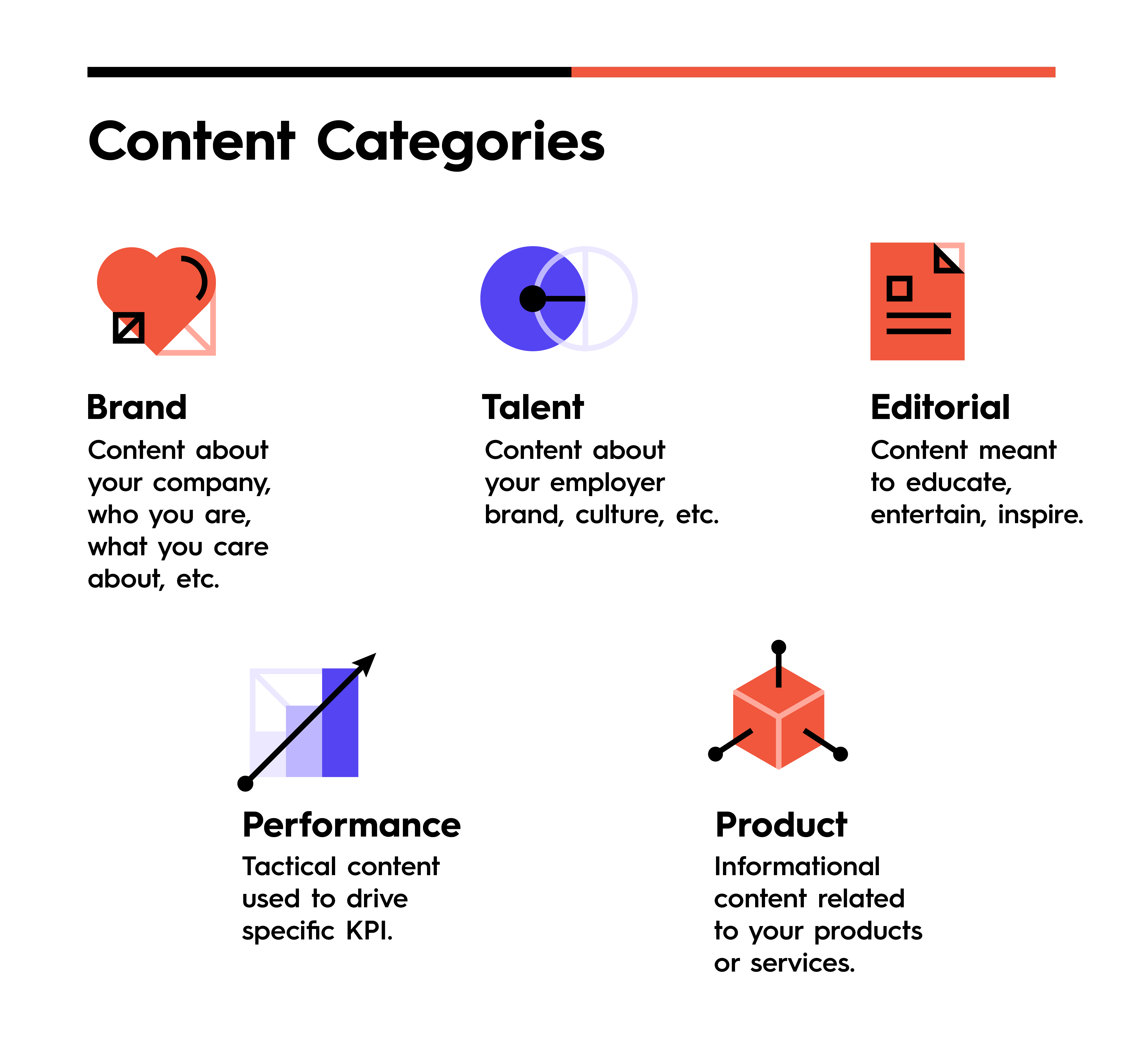If you want to tell strong stories that reach the right audience (and convert them), you need a cohesive content strategy that is tied to clear goals—and optimized to support them. Essentially, you want to create a holistic content ecosystem that spans your buyer journey and gives your audience exactly what they need to move from one stage to the next. But how do you create that content experience? Do a content audit on your own brand, as well as your competitors, to understand what you’re doing right, where you’re missing out, and how you can improve overall.

What Is a Content Audit?
A content audit is the process of taking a critical look at your content marketing, as well as your competitors’ content, to gauge how you’re presenting your brand to the world, how you stack up against the competition, opportunities to improve, etc. By reviewing your content as a whole (and comparing it to others in your space), you can get a bird’s eye view to realign your marketing, fill missing gaps, craft a more effective strategy, and gain a competitive edge.
The Biggest Benefits of a Content Audit
We’ve said it before, and we’ll say it a hundred more times: When you’re working on your brand day in and day out, it’s easy to get tunnel vision. (We know this because it happens to us too.) We all have blind spots, especially if you’re deeply immersed in your brand, so it’s important to take a step back to see the bigger picture, get a sense of the competitive landscape, and assess whether the content you’re creating connects to your larger goals or not. That’s why a content audit can be so beneficial to spot opportunities to win and work more effectively.
- Identify best-performing content. According to the Content Marketing Institute (CMI), 57% of B2B marketers cite creating the “right” content for their audience as one of their top challenges. What is the “right” content? The content that your audience is most likely to gravitate toward. This is why it’s important to regularly assess your top-performing content, break down why it was so popular, and translate those insights into new content that is just as successful.
- Spot gaps in your content marketing. According to CMI, 54% of B2B marketers say differentiating their content is one of their biggest challenges. With the advent of AI-generated content, differentiation will be harder and more important than ever, and a content audit is one of the most helpful ways to find opportunities to differentiate. Whether it’s filling the content gaps your competitors have missed, tweaking the type of content formats you create, or revising your value prop to stand out, the more you know about how your competitors are positioning themselves through content, the easier it is to stand out.
- Repurpose content. Across the board, marketers are being asked to do more with less. (According to CMI, 58% of B2B marketers cite a lack of resources as their biggest barrier to successful content creation.) Content creation is an investment, so you need to get the most from every piece you create. A content audit helps you get a solid picture of the content you already have—and can inspire you to repurpose, reuse, or remix that content in even more effective ways.
- Get more inspiration. Although your competition may be dropping the ball in some areas, they’re likely knocking it out of the park in other areas. A competitor content audit always generates fascinating insights and can even inspire you to adapt some of their tactics. For example, they may have created an impressive tool or a successful series of funny videos that delivered a strong message. You don’t want to copy them, but their creativity can activate your own creativity (and maybe a little competitive streak).
Trust us, although a content audit takes time, it is an important pursuit that will generate real ROI.
How to Do a Content Audit
Whether you’re a new startup with very little content or a legacy brand with thousands of pieces in your archive, don’t worry. Here, we’ve broken down the step-by-step process—along with a free downloadable template—to get the insights you need without spending days of your life digging through your archives.

You can use the same template and steps for your competitor audit as well. (BTW, as you work through these templates, you don’t have to write a novel for each answer. Keep your answers succinct, simple, and clear.)
Note: You may be a new startup with very little content, or a legacy brand with thousands of pieces in your archive. Either way, don’t worry. Here, we’ll walk you through the step-by-step process to get the insights you need—without spending days of your life digging through your archives:)
Note: You’ll repeat the following steps for both your own content and your competitors’ content. We recommend completing your own audit first, then doing your competitor audit.
Step 1: Gather your content.
Blog articles, social posts, explainer videos—every brand creates a variety of content across channels and across the buyer journey. This content generally falls into five main categories.
- Brand: This is content about a company specifically (not its product), such as the Brand Heart (purpose, vision, mission, values), events, news, etc. Some of this content may be internal-facing only; some may be external.
- Talent: This is content about a company’s employer brand, company culture, etc.
- Editorial: This is content meant to educate, entertain, inspire, or demonstrate brand expertise or thought leadership, such as articles, guest posts, infographics, blogs, industry-related content, etc.
- Product: This is more informational content related to products or services, such as sales materials, demos, explainer videos, or educational content.
- Performance: This is tactical content used to drive a specific KPI, such as landing pages, CTAs, PPC, etc.
The good news is you don’t have to review every single piece of content you or your competition has ever created—just a sample for each category.

Auditing Your Own Content
Pull a sample batch of 5-10 pieces of your most recent and successful pieces of content per category.
- Successful = top-performing content per your analytics (e.g., highest traffic, conversions, engagement, etc.).
- Recent = content from your last year or two. (While you may have a decade-old post that generates tons of traffic, you want to know how your current efforts are working.)
Frankly, you can pull as many samples as you like, but 5-10 is a healthy amount that won’t overwhelm you. If you create a variety of content formats (e.g., infographics, videos, e-books), include a variety of those most successful pieces too. Your goal is to get a representative sample that will give you a sense of how you’re communicating in each category.
Note: If you don’t have that much content, or don’t have content in every area, that’s OK. Pull what you have.
Auditing Your Competitor’s Content
Pull a similar batch of content. To figure out their most popular/successful content, look at their most popular content on social, content that outranks you in SEO, etc.
Depending on the focus of your content strategy, you may want to focus on particular categories (e.g., their editorial content vs. their talent content). That’s up to you. Just make sure you have a healthy selection of content from your top three competitors. (Again, you can audit as many competitors as you like, but your top 10 are your most relevant.)
Step 2: Review one category of content at a time.
It can be overwhelming to pull insights from 25-50 pieces of content at a time, which is why we recommend focusing on one category at a time and documenting your collective observations. This way you can compare insights from category to category, instead of piece to piece.
Start with your first category (e.g., Brand). Review those 5-10 pieces, and answer the template questions about your observations.
- What stage of buyer journey is it made for? Your content strategy should have a healthy mix of content that spans the buyer journey. If you’re overly focused on one stage, you may need to fill in the gaps across the journey.
- What persona does this content speak to? If one persona is targeted more than others, your content strategy may need to prioritize content for a neglected group.
- Does content come in a variety of formats? Depending on your channel mix, you may want to expand your strategy to include more types of content (think articles, video, infographics, interactives, etc.).
- Does the content reflect brand voice/personality/visual identity? Would someone be able to identify your brand’s content at a glance? Remember: Consistency is key.
- Is there a clear CTA? Do viewers have a clear next step? Is it tailored to the persona?
- What does the most successful content have in common? Consider things like topic, format, etc.
- What channels are used to promote? Is this content well-suited for your distribution channels? Are there other channels to consider?
- Any notable observations? Document anything that stands out to you (good, bad, or interesting).
Step 3: Look for trends across categories.
As you review each category, look for common threads, inconsistencies, messaging gaps, etc. These will shed light on your strengths, weaknesses, and opportunities.
For example, you may create quality content on a variety of interesting subjects but your CTAs are weak. You may find that your copywriting is great but your design is lackluster. Or you may find that your branding is inconsistent across formats.
Step 4: Repeat the process for your competition.
In reviewing your competitors’ content, you will likely see even more opportunities to fill the gap, outrank, and outshine them. You will also probably notice areas where you’re falling short. For example, they may be publishing much more often than you or creating much more in-depth posts that outrank you.
It can be frustrating to shine a light on these weak areas, but they can also serve as inspiration.
Step 5: Craft your takeaways.
Having reviewed the insights from your own content audit and your competitors’, you should have the information you need to improve your content strategy.
To make these items actionable, document your biggest opportunities for improvement in…
- Personas
- Buyer Journey
- Messaging
- Topics
- Formats
- Distribution
- Other
 How to Put Your Content Audit to Use
How to Put Your Content Audit to Use
Now that you’ve done all that work, you’re ready to build a content strategy that gets real results. For next steps…
- See our guide to improve your content strategy.
- Revise your customer journey to make sure you’re saying the right thing at the right time.
- Follow our guide to create strong personas that help you connect with the right people.
- Find out how to choose the right metrics for your content strategy.
And if you need a partner to help you build a strategy (or execute the one you have), find out more about what we do, and what you’ll get when you work on content strategy with us.




